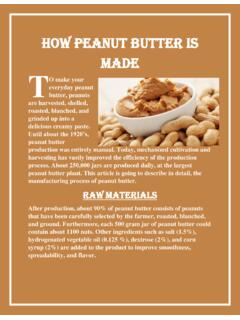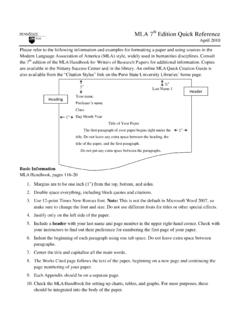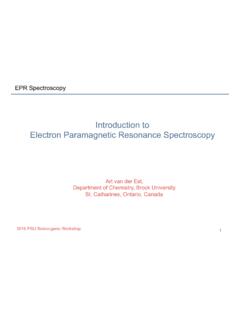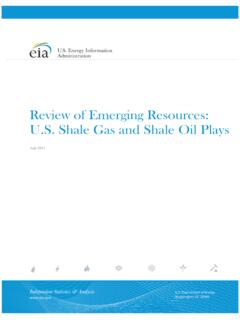Transcription of Determination of Porosity for Core Samples and ...
1 1 Determination of Porosity for Core Samples and Interconnected Void Space of Marbles Through: Bulk Volume, Barnes Method, and Helium Porosimeter Nick Desiderio, March 3, 2014 Abstract Geological formations often hold fluids such as gas and oil within void space known as pores. Conventional oil and gas migrates between porous mediums until it is capped by impermeable rocks. The Marcellus shale located in northeastern Pennsylvania provides a source of unconventional gas. natural gas trapped within the pores of the shale is unable to be extracted by conventional means. Techniques such as hydraulic fracturing and horizontal drilling have been developed to extract this gas. Porosity is an important rock property that describes a porous medium s ability to hold fluids such as oil and gas.
2 This property is also useful in carbon capture and storage methods which require the sequestration of CO2 within porous formations such as sandstone. Three methods were used to determine the Porosity of a marble pack and core Samples . The methods incorporated Barnes method, helium Porosity , and additional methods. Helium Porosity was utilized to measure microscopic pores contained within core Samples usually impenetrable by normal fluids. The effective Porosity of the marble pack was expected to be relatively high because of the uniform shape and size of the marbles. The effective Porosity was measured to be which corresponded with expectations. The Porosity of four core Samples of different composition was found to range from Sample 1 contained the highest density at g/cm3 and lowest Porosity at Sample 5 had the lowest density at g/cm3 and the highest Porosity at This demonstrated the inversely proportional relationship of Porosity and density.
3 The helium Porosity of two core Samples were found to be and Porosity , density, and permeability are all important parameters and properties to consider with regards to oil and gas industry. At deep depths, Porosity of geological formations can be evaluated based on well logged data. As the need for energy demands increase, deeper and newer extractions methods must be utilized to obtain fuel. Physical rock properties will determine whether unconventional fuel can be extracted. Introduction The depletion of abundant fossil fuels has caused need for alternative source locations and fuel extraction methods. Oil and gas production techniques have advanced to the point of extracting fuel sources from unconventional sources such as the Marcellus shale located in the northeast of the United Physical properties of geological formations such as Porosity , density and permeability are important parameters to be considered during oil and gas When the rock Samples are not available, such as oil and gas drilling and mining at deep depth, the well log data and geophysical data can be used to analyze and interpret rock physical and mechanical Porosity , an important parameter.
4 Is the volume of open space or space between the solid mineral components or unconsolidated sediments that make up Permeability is another key parameter that defines the ability of a rock to transmit Although closely related, Porosity and permeability are different. Petroleum and natural gas conventional sources 2 are often found in permeable, porous rocks such as sandstone, where natural gas or oil migrates toward an area of lower pressure and eventually can consolidate the resource in pools or pockets. 2 Recovery of oil and gas begins with primary recovery, which relies on natural pressure in reservoirs to force oil to the Secondary recovery is than utilized by injecting water into the reservoir to push oil to the These methods may only account for the accumulation of 20 to 40% of fuel within the A tertiary recovery method known as enhanced oil recovery uses methods of gas injection, heating, chemical additives, and microbes to boost the amount of oil recovery by 30 to 60%.
5 1 This method can have a double benefit of carbon dioxide sequestration by using CO2 as the fluid injection Injecting CO2 deep within geological formations pushes oil out due to pressure The gaseous carbon dioxide is also unable to penetrate fine pores and fissures in the reservoir rocks causing it to be Thermal cracking methods are used to break down hydrocarbon molecules to optimize gasoline This method relies on the important parameter of Porosity ; zeolites, an enormous family of aluminosilicates, are used in cracking processes as catalysts and are highly Synthetic zeolites contain properties that can be modified such as the diameter of pore About 95% of catalytic cracking units in the United States use zeolite Hydrocarbon molecules in cracking access the cage or pore of zeolites which only permits molecules of certain sizes and shape to enter and Large alkanes cannot pass through the cage and react on the surface of the The breakdown of smaller hydrocarbon molecules leads to the formation of The objective of this study was to quantify and evaluate density and Porosity characteristics of core Samples and a consolidation of marbles.
6 Effective Porosity represents the ratio of the interconnected pore space to the total bulk volume of the The effective Porosity of the marble consolidation was quantified by dividing the volume of water in the pores by the total water and marble volume. Barne s method was used to determine the effective Porosity of six sample cores. Helium gas is used to measure the true density and true Porosity with the assumption that helium being the smallest atom should be able to penetrate the smallest of pores whereas other fluids may A helium porosimeter was utilized to calculate and evaluate the density and helium Porosity of two core Samples . Theory Porosity is an important property to analyze in regards to oil and gas reservoir and aquifer Porous geological mediums contain natural gas and oil deposits within their Porosity is defined to be the ratio of a volume of void spaces within a rock to the total bulk volume of the There are several engineering descriptions that classify Porosity , but the two most common are absolute and effective Equation 1 shows the calculation for absolute Porosity (Ф), where Vpores, the pore volume, is divided by Vbulk, the bulk The Porosity is calculated as a percentage of the total Ф = (Vpores/Vbulk) (1)
7 Effective Porosity is another method in classifying Porosity and represents the ratio of the interconnected pore space to the total bulk volume of the Therefore, effective Porosity is 3 also referred to as interconnected Effective Porosity is the preferred measure in petroleum engineering fields as it relates to fluid The fluids in interconnected void spaces contribute to fluid flow within the porous Equation 2 shows the calculation of Porosity where Vinter represents the interconnected pore volume, and Vbulk represents the bulk volume of the Ф = (Vinter/Vbulk) (2) Porosity is primarily controlled by the shape, size and arrangement of the rock It also depends on rock mechanical processes such as compaction, deformation, fracture evaluation and geochemical processes such as dissolution, precipitation, mineralogical The diagram shown in figure 1 demonstrates the properties of shape, size, and arrangement of rock gains which contributes to the Porosity and fluid Figure 1.
8 Shape, size, arrangement diagram of rock grains. Barne s method is utilized in Porosity Determination to directly measure the Porosity of macrosoporous Barne s method involves adsorption techniques which rely on liquids being adsorbed into the pores of a solid Complete saturation of pore spaces in the sample by the fluid adsorbed into the pores determines the pore The weight of the adsorbed liquid, divided by the density of the liquid yields pore volume which can is further compared to the bulk volume of the Barne s method is an important technique often used in petroleum industry to understand oil and gas flow of geological Helium gas is used to measure the true density and true Porosity with the assumption that helium being the smallest atom should be able to penetrate the smallest of pores whereas other fluids may A helium porosimeter was utilized to calculate and evaluate the density and helium Porosity of two core Samples .
9 Small helium atoms are able to penetrate the microscopic pores of cores Samples and adsorb to the porous This Determination measures the 4 Porosity of core Samples most The helium porosimeter uses Boyle s Law for the calculation of grain volume by the equalization of The calibration equation utilized by the helium porosimeter is shown in equation 3 where P1 and P2 are the pressures, and Vdisc is the volume of the discs that seal the sample Grain Volume = x (P1/P2) + Vdisc (3) Discs are used to seal the sample chamber while helium fills the core The addition of these discs prevents the volume above the sample from being Therefore, the subtraction of the disc volume is necessary in the calculation of grain volume as If the core rock sample is a perfect cylinder with smooth surfaces, then caliper measurements of length and diameter can give accurate bulk Accurate Porosity must depend mainly upon surface texture of the core Helium expansion determinations of Porosity on Samples with smooth surface textures where the caliper bulk volume is used should fall within Porosity percent regardless of actual High permeability sandstone Samples have large grain and pore sizes.
10 And do not produce smooth surfaced right cylinders when plugs are drilled which makes accurate bulk volume Determination becomes Methods Porosity of a porous medium is often influenced by geological location and formation which has effects on properties such as size, shape, and arrangement of particle grains. Through this study, quantification and exploration of Porosity was conducted by three concise methods. The packing efficiency of marbles was examined as 30 marbles were consolidated together. The addition of fluid (water) to the marble pack demonstrated the pore interconnectivity. The fluid migrated to the void space between the marbles and further occupied it. Using known marble volumes and fluid addition, the effective Porosity was determined and examined.












